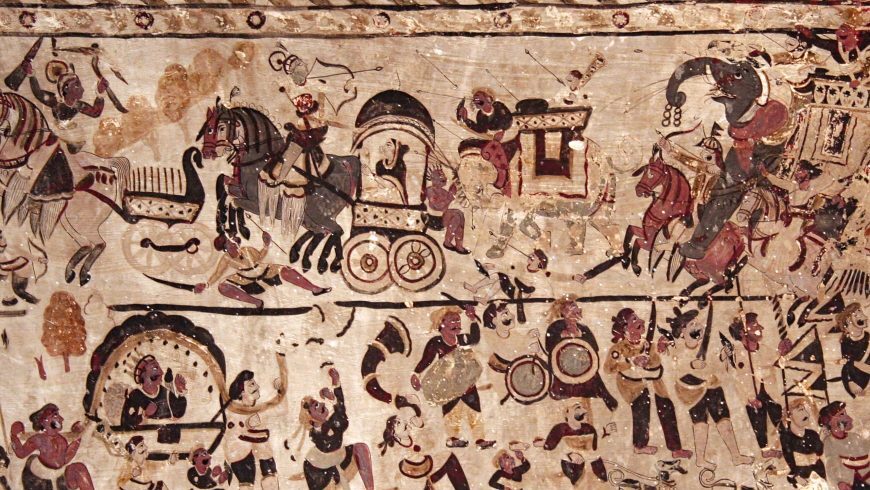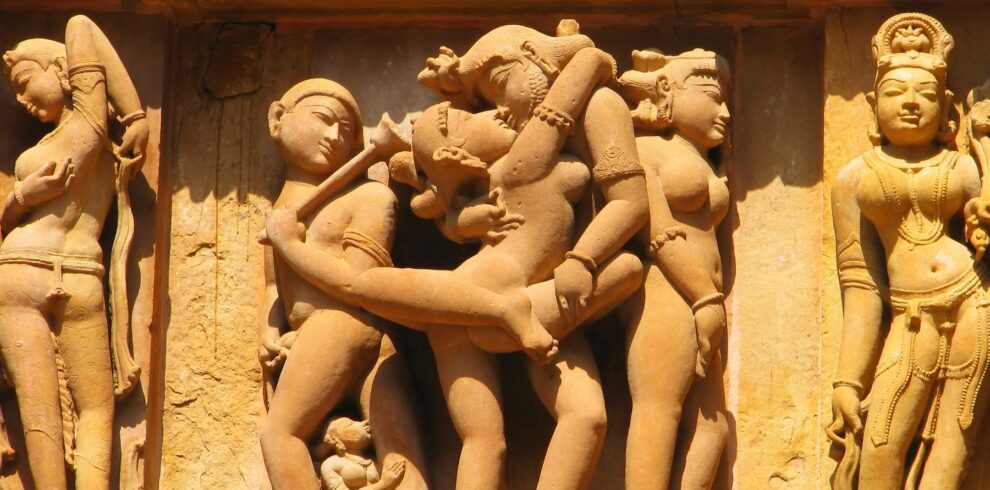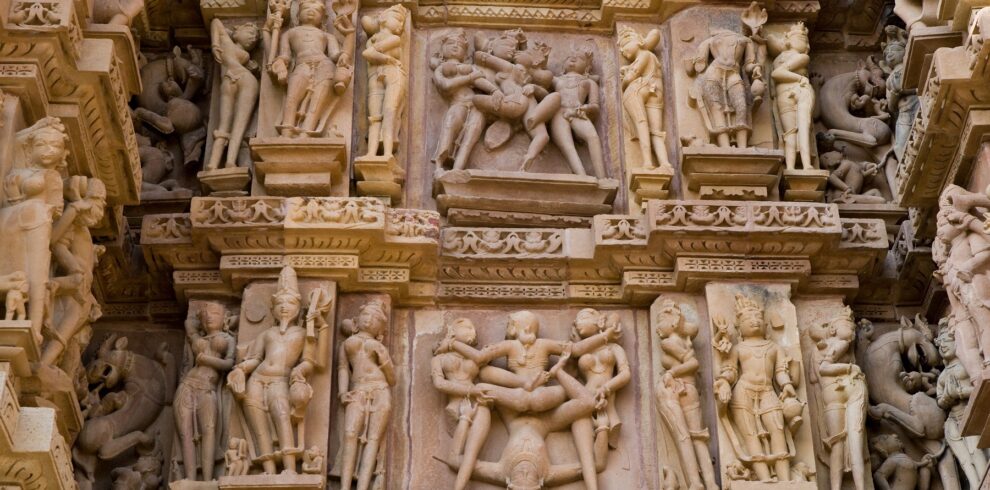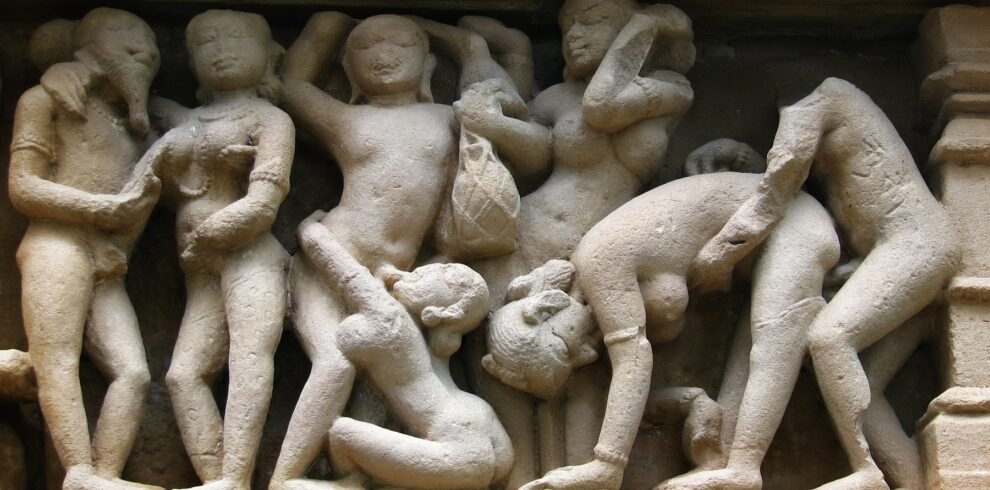Khajuraho
Khajuraho, located in the Chhatarpur district of Madhya Pradesh, India, is renowned for its stunning group of medieval Hindu and Jain temples. These temples, built between the 9th and 11th centuries by the Chandela dynasty, are famous for their intricate carvings and elaborate sculptures, which depict various aspects of life, mythology, and spirituality.
The Khajuraho Group of Monuments is a UNESCO World Heritage Site and is considered one of the finest examples of temple architecture in India. The temples are divided into three groups – the Western Group, Eastern Group, and Southern Group – with the Western Group being the most prominent and visited.
The temples at Khajuraho are known for their exquisite craftsmanship and architectural brilliance. They are built using sandstone and feature intricate carvings that depict gods and goddesses, celestial nymphs (apsaras), mythical creatures, everyday life scenes, and erotic motifs. The erotic sculptures, though a small percentage of the total artwork, are some of the most famous and attract visitors from around the world.
Despite their age, many of the sculptures at Khajuraho remain remarkably well-preserved, providing valuable insights into ancient Indian art and culture. The temples are not only architectural marvels but also serve as important religious sites for worship and pilgrimage for Hindus and Jains.
In addition to exploring the temples, visitors to Khajuraho can also enjoy the vibrant local culture, including traditional dance performances, music, and handicrafts. The town hosts various cultural events and festivals throughout the year, including the Khajuraho Dance Festival, which showcases classical Indian dance forms against the backdrop of the magnificent temples.
Overall, Khajuraho is a must-visit destination for travelers interested in history, art, and culture, offering a mesmerizing journey through India’s rich architectural heritage and artistic traditions.
City Tour

- Jan
- Feb
- Mar
- Apr
- May
- Jun
- Jul
- Aug
- Sep
- Oct
- Nov
- Dec

- Jan
- Feb
- Mar
- Apr
- May
- Jun
- Jul
- Aug
- Sep
- Oct
- Nov
- Dec

- Jan
- Feb
- Mar
- Apr
- May
- Jun
- Jul
- Aug
- Sep
- Oct
- Nov
- Dec
Cultural Tours
Tourism is travel for pleasure or business; also the theory and practice of touring, the business of attracting, accommodating, and entertaining tourists, and the business of operating tours. Tourism may be international, or within the traveller’s country. The World Tourism Organization defines tourism more generally, in terms which go “beyond the common perception of tourism as being limited to holiday activity only”, as people “traveling to and staying in places outside their usual environment for not more than one consecutive year for leisure, business and other purposes”.
Tourism can be domestic or international, and international tourism has both incoming and outgoing implications on a country’s balance of payments. Today, tourism is a major source of income for many countries, and affects the economy of both the source and host countries, in some cases being of vital importance.

- Jan
- Feb
- Mar
- Apr
- May
- Jun
- Jul
- Aug
- Sep
- Oct
- Nov
- Dec

- Jan
- Feb
- Mar
- Apr
- May
- Jun
- Jul
- Aug
- Sep
- Oct
- Nov
- Dec

- Jan
- Feb
- Mar
- Apr
- May
- Jun
- Jul
- Aug
- Sep
- Oct
- Nov
- Dec
Day Tour

- Jan
- Feb
- Mar
- Apr
- May
- Jun
- Jul
- Aug
- Sep
- Oct
- Nov
- Dec
Jungle Safari
A is an overland journey, usually a trip by tourists to Africa. In the past, the trip was often a big-game hunt, but today, safari often refers to trips to observe and photograph wildlife—or hiking and sightseeing, as well.
The Swahili word safari means journey, originally from the Arabic meaning a journey; the verb for “to travel” in Swahili is kusafiri. These words are used for any type of journey, e.g. by bus from Nairobi to Mombasa or by ferry from Dar es Salaam to Unguja. Safari entered the English language at the end of the 1850s thanks to Richard Francis Burton, the famous explorer.
The Regimental March of the King’s African Rifles was ‘Funga Safari’, literally ‘tie up the March’, or, in other words, pack up equipment ready to march.
In 1836 William Cornwallis Harris led an expedition purely to observe and record wildlife and landscapes by the expedition’s members. Harris established the safari style of journey, starting with a not too strenuous rising at first light, an energetic day walking, an afternoon rest then concluding with a formal dinner and telling stories in the evening over drinks and tobacco.

- Jan
- Feb
- Mar
- Apr
- May
- Jun
- Jul
- Aug
- Sep
- Oct
- Nov
- Dec

- Jan
- Feb
- Mar
- Apr
- May
- Jun
- Jul
- Aug
- Sep
- Oct
- Nov
- Dec
Multi Day Tour

- Jan
- Feb
- Mar
- Apr
- May
- Jun
- Jul
- Aug
- Sep
- Oct
- Nov
- Dec

- Jan
- Feb
- Mar
- Apr
- May
- Jun
- Jul
- Aug
- Sep
- Oct
- Nov
- Dec


